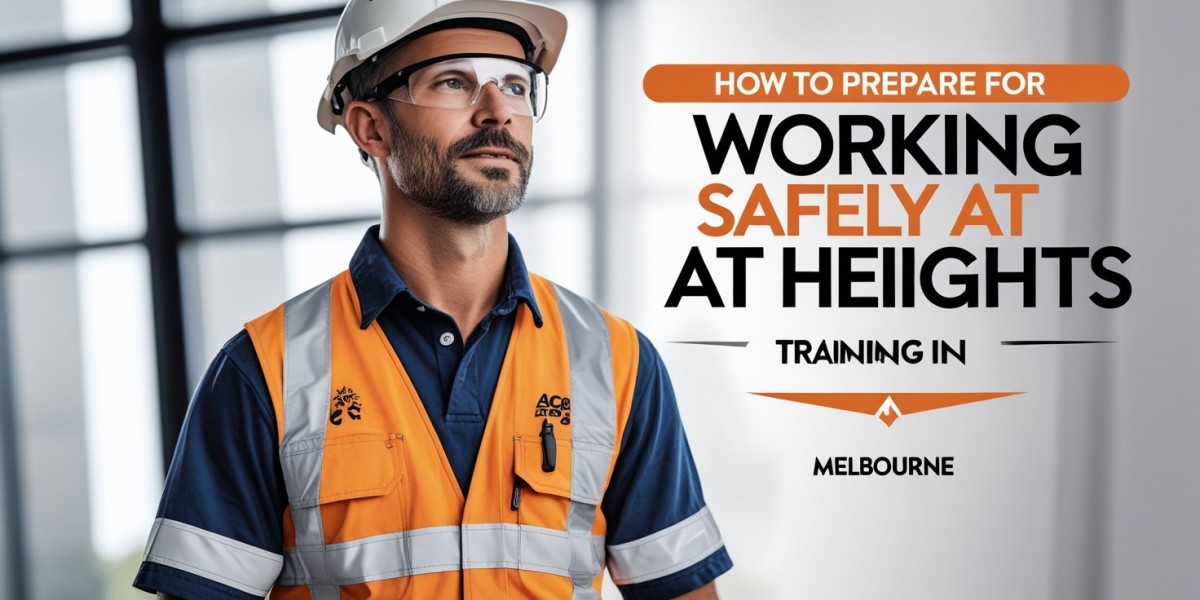Working at heights is inherently risky, and in Melbourne’s bustling industrial and construction sectors, safety is paramount. Whether you're new to the workforce or looking to renew your certification, preparing for Working Safely at Heights training is essential for ensuring your own safety and the safety of others. This blog will guide you through the key steps you can take to prepare effectively and get the most out of your training experience.
1. Understand Why the Training is Important
Before diving into preparation, it’s crucial to understand why this training matters. Working at heights remains one of the leading causes of serious injuries and fatalities in Australian workplaces. The training helps identify hazards, implement control measures, and ensure compliance with legal and safety standards. By preparing well, you set the stage for a safer work environment.
2. Know the Legal Requirements in Victoria
Victoria's Occupational Health and Safety (OHS) regulations mandate specific guidelines for working at heights, especially for work done above two meters. Being familiar with these laws will help you appreciate the gravity of the training and its direct impact on your day-to-day responsibilities. Training must be conducted by a registered RTO (Registered Training Organisation) that meets the national safety competency requirements.
3. Choose the Right Training Provider
Melbourne offers a range of training providers, so choosing the right one is crucial. Look for providers that are nationally accredited, offer hands-on practical training, and have experienced trainers. Check reviews, testimonials, and course inclusions. A good provider will also supply safety gear during the course and offer post-training support.
4. Review the Course Content in Advance
Understanding the topics beforehand helps you absorb more during the actual session. Most Working Safely at Heights courses in Melbourne cover:
Risk assessment and hazard identification
Use of fall protection equipment
Rescue procedures
Ladder safety
Understanding SWMS (Safe Work Method Statements)
Pre-reading course materials, if provided, will give you a significant advantage during the training.
5. Get Physically Ready
Working at heights requires a reasonable level of physical fitness. The training will often involve climbing ladders, harnessing up, and participating in simulated rescue exercises. Get a medical check-up if needed and inform the training provider in advance if you have any physical restrictions. Light exercise and stretching before the course can help you perform better during practical exercises.
6. Dress Appropriately for Training
You’ll need to wear appropriate clothing for practical training exercises. This includes:
Long pants and a long-sleeved shirt
Steel-toed boots or sturdy footwear
No loose jewelry or accessories
The training provider may supply PPE (Personal Protective Equipment), including a safety harness, helmet, and gloves. Dressing appropriately shows professionalism and ensures you're safe and comfortable throughout the training.
7. Be Mentally Prepared
Mental preparation is just as vital as physical readiness. Working at heights requires focus, composure, and the ability to remain calm in high-risk scenarios. Sleep well the night before, stay hydrated, and arrive early on the day of training. A positive, attentive mindset will help you absorb more and perform better.
8. Brush Up on Basic Safety Knowledge
Refreshing your understanding of general workplace safety concepts—like hazard identification, PPE, and safety signage—can be helpful. These are foundational elements in most training programs and can improve your comprehension during the session. Resources like Safe Work Australia’s website offer free access to up-to-date guidelines.
9. Understand Your Workplace Environment
If you’re taking the training because of a specific job requirement, study your worksite in advance. Ask yourself:
What type of height-related work will I be doing?
What equipment is commonly used?
Are there any known hazards on-site?
Having this context allows you to ask more relevant questions during training and relate practical exercises back to your real-world scenarios.
10. Prepare Questions in Advance
Go into the training with a curious mindset. Prepare questions such as:
What are the best practices for harness inspection?
How do you ensure anchorage points are secure?
What are emergency response procedures?
Asking questions helps clarify doubts and shows your instructor that you’re genuinely engaged and invested in learning.
11. Bring Necessary Documentation
Most providers require identification (such as a driver’s license) and sometimes proof of employment or a white card. Make sure to check the training provider’s website or contact them directly to verify what documents you’ll need. Forgetting these can delay or even prevent you from taking the course.
12. Learn About Fall Protection Systems
The core of Working Safely at Heights training revolves around fall protection. Learn about:
Fall arrest systems
Fall restraint systems
Work positioning systems
Safety nets and scaffolds
A basic understanding of these can help you grasp complex concepts during training and perform better during assessments.
13. Get Familiar with Emergency Procedures
Rescue planning and emergency procedures are critical components of working at heights. Knowing the basics of:
Self-rescue
Assisted rescue
Emergency communication
It can prepare you for what to expect during the practical exercises and assessments.
14. Be Open to Hands-On Learning
Training is often conducted using real-world simulations. Be prepared to engage in climbing, harness fitting, anchor point inspections, and mock rescues. Take this seriously—this is your chance to learn the techniques that might one day save your life.
15. Practice Good Communication Skills
Team communication is essential when working at heights. The training often involves exercises where you work with others. Practicing clear, concise, and assertive communication can enhance your performance and make you a reliable team member during real-life tasks.
16. Understand Assessment Criteria
The course will typically end with a written and practical assessment. Knowing this in advance helps you focus better during training. Ask your trainer about the evaluation process and what they expect from students to pass the course.
17. Follow Up After Training
Once you’ve completed the training, your next step is to apply your knowledge. Some providers offer additional resources like refresher videos, checklists, or mentoring programs. Stay connected and periodically review what you've learned to ensure long-term retention.
18. Keep Your Certificate Safe
You’ll receive a Statement of Attainment once you pass the course. This document is often required by employers and site managers before you can begin work. Store it safely and consider making digital copies for easy sharing.
19. Plan for Refresher Courses
Certifications don’t last forever. In high-risk industries, it's recommended to renew Working at Heights training every two years. Planning in advance ensures you never have a gap in your certification, which could otherwise delay projects or affect employment.
20. Share Your Knowledge
The best way to reinforce what you’ve learned is by sharing it with colleagues or team members. Offer to demonstrate proper harness use or lead toolbox talks. This not only solidifies your understanding but also contributes to a safer workplace culture.
Conclusion
Preparing for Working Safely at Heights training in Melbourne goes beyond just showing up to class. It requires a combination of physical readiness, mental preparedness, background research, and active participation. By following the points above, you not only increase your chances of passing the course but also build a strong foundation for a safe and successful career in any height-related industry. Remember—safety is not a destination but a continuous journey, and your preparation plays a key role in that process.
FAQs
1. How long does the Working Safely at Heights training in Melbourne take?
Most courses are completed in one day, lasting around 8 hours. Some intensive versions may span two days, especially if bundled with other safety modules.
2. Do I need prior experience to take the training?
No prior experience is required. The course is designed for both beginners and professionals looking to renew their certification.
3. What happens if I fail the assessment?
If you don’t pass, most providers offer a second attempt or supplementary training. Check with your RTO about their specific policy.
4. Is online training for working at heights accepted in Melbourne?
While theory components may be offered online, the practical elements must be completed in person to meet safety standards and compliance regulations.
5. What kind of jobs require this training?
Jobs such as construction worker, roofer, scaffolder, telecommunications technician, and maintenance personnel often require Working Safely at Heights certification.







